Related Research Articles

The Battle of Iwo Jima was a major battle in which the United States Marine Corps (USMC) and United States Navy (USN) landed on and eventually captured the island of Iwo Jima from the Imperial Japanese Army (IJA) during World War II. The American invasion, designated Operation Detachment, had the purpose of capturing the island with its two airfields: South Field and Central Field.

Sands of Iwo Jima is a 1949 war film starring John Wayne that follows a group of United States Marines from training to the Battle of Iwo Jima during World War II. The film, which also features John Agar, Adele Mara and Forrest Tucker, was written by Harry Brown and James Edward Grant, and directed by Allan Dwan. The picture was a Republic Pictures production.

Ira Hamilton Hayes was an Akimel O'odham Native American and a United States Marine during World War II. Hayes was an enrolled member of the Gila River Indian Community, located in Pinal and Maricopa counties in Arizona. He enlisted in the United States Marine Corps Reserve on August 26, 1941, and, after recruit training, volunteered to become a Paramarine. He fought in the Bougainville and Iwo Jima campaigns in the Pacific War.
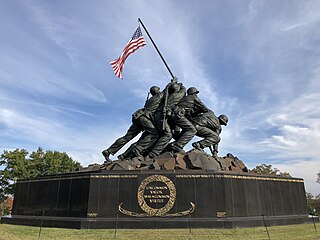
The United States Marine Corps War Memorial is a national memorial located in Arlington County, Virginia. The memorial was dedicated in 1954 to all Marines who have given their lives in defense of the United States since 1775. It is located in Arlington Ridge Park within the George Washington Memorial Parkway, near the Ord-Weitzel Gate to Arlington National Cemetery and the Netherlands Carillon. The memorial was turned over to the National Park Service in 1955.
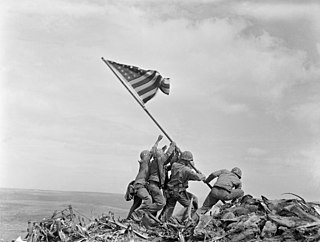
Raising the Flag on Iwo Jima is an iconic photograph of six United States Marines raising the U.S. flag atop Mount Suribachi during the Battle of Iwo Jima in the final stages of the Pacific War. The photograph, taken by Joe Rosenthal of the Associated Press on February 23, 1945, was first published in Sunday newspapers two days later and reprinted in thousands of publications. It was the only photograph to win the Pulitzer Prize for Photography in the same year as its publication, and was later used for the construction of the Marine Corps War Memorial in 1954, which was dedicated to honor all Marines who died in service since 1775. The memorial, sculpted by Felix de Weldon, is located in Arlington Ridge Park, near the Ord-Weitzel Gate to Arlington National Cemetery and the Netherlands Carillon. The photograph has come to be regarded in the United States as one of the most significant and recognizable images of World War II.
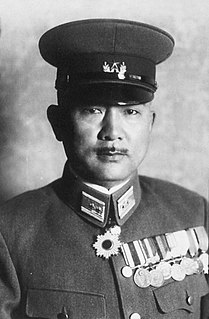
General Tadamichi Kuribayashi was a general in the Imperial Japanese Army, part-time writer, haiku poet, diplomat, and commanding officer of the Imperial Japanese Army General Staff. He is best known for having been the commander of the Japanese garrison at the battle of Iwo Jima.
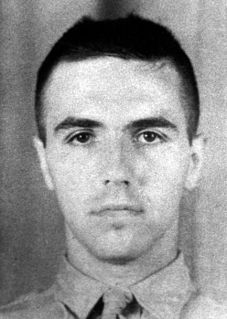
René Arthur Gagnon was a United States Marine Corps corporal who participated in the Battle of Iwo Jima during World War II.
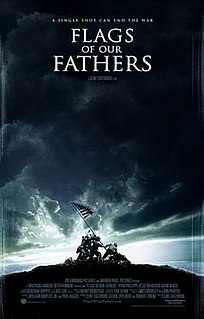
Flags of Our Fathers is a 2006 American war film directed, co-produced, and scored by Clint Eastwood and written by William Broyles Jr. and Paul Haggis. It is based on the 2000 book of the same name written by James Bradley and Ron Powers about the 1945 Battle of Iwo Jima, the five Marines and one Navy corpsman who were involved in raising the flag on Iwo Jima, and the after effects of that event on their lives.

Gunnery Sergeant William Gary Walsh was a United States Marine who heroically sacrificed his life to save the lives of his fellow Marines during the Battle of Iwo Jima during World War II. For his actions on February 27, 1945, he posthumously received the Medal of Honor.

The 28th Marine Regiment is an infantry regiment of the United States Marine Corps. The regiment which is part of the 5th Marine Division, fought in the Battle of Iwo Jima during World War II. Six Marines of the 2nd Battalion, 28th Marines were featured in the historical photo by Joe Rosenthal of the U.S. flag raising on top of Mount Suribachi.

The 2nd Battalion, 28th Marine Regiment is an infantry battalion of the United States Marine Corps. The battalion which is part of the 28th Marine Regiment, 5th Marine Division, fought in the Battle of Iwo Jima during World War II. Six Marines of E Company, 2nd Battalion, 28th Marines were featured in the historical photo by Joe Rosenthal of the U.S. flag raising on top of Mount Suribachi.
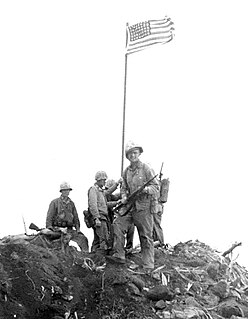
Ernest Ivy "Boots" Thomas Jr. was a United States Marine Corps platoon sergeant who was killed in action during the Battle of Iwo Jima in World War II. He was awarded the Navy Cross for extraordinary heroism while fighting for and at the base of Mount Suribachi. Two days later he was a member of the patrol that captured the top of Mount Suribachi where he helped raise the first U.S. flag on Iwo Jima on February 23, 1945. He was killed eight days after that.

Camp Tarawa was a training camp located on Hawaiʻi Island constructed and used by the 2nd Marine Division during World War II. The grounds of the camp were situated between the volcanic peak of Mauna Kea and Kohala mountain. Marines were sent straight from the bloody Battle of Tarawa to the campsite, which they had to build themselves. It was well known for its harsh and dusty conditions by Marines who trained there. After the 2d Marine Division left for Saipan, the 5th Marine Division moved into the base and trained for the Battle of Iwo Jima. The base was closed for good in November 1945.

Raymond E. Jacobs was an American and United States Marine Corps sergeant who served in combat during World War II. Jacobs was a member of the combat patrol that climbed up to the top of Mount Suribachi during the Battle of Iwo Jima and raised the first U.S. Flag on February 23, 1945. Afterwards, he was a news reporter and had served during the Korean War as an instructor at Camp Pendleton, California.
John Keith Wells was a United States Marine during World War II who led one of the most decorated infantry platoons to come out of a single engagement and the first to raise a flag over the Japanese island of Iwo Jima during World War II, 3rd Platoon, Easy Company, 2nd Battalion, 28th Marines, 5th Marine Division. This platoon was made famous for its attack on Mount Suribachi and for raising the first flag on the summit.
Robert Lee Sherrod was an American journalist, editor and writer. He was a war correspondent for Time and Life magazines, covering combat from World War II to the Vietnam War. During World War II, embedded with the United States Marine Corps, he covered the battles at Attu, Tarawa, Saipan, Iwo Jima, and Okinawa. He also authored five books on World War II, including Tarawa: The Story of a Battle (1944) and the definitive History of Marine Corps Aviation in World War II (1952). He was an editor of Time during World War II and later editor of The Saturday Evening Post, then vice-president of Curtis Publishing Company.
Charles William Tatum was an American World War II veteran, Bronze Star recipient, race car driver and builder. On 19 February 1945, he was among the first wave of marines to land on the Japanese island stronghold of Iwo Jima. He was a friend of John Basilone.
Dave Elliott Severance was a United States Marine Corps colonel. During World War II, he served as the commanding officer of Easy Company, 2nd Battalion, 28th Marines and led his company in the battle of Iwo Jima. During the battle, Severance ordered his 3rd Platoon to scale Mount Suribachi and raise the flag at the summit.
John Augustus Butler was a highly decorated United States Marine Corps lieutenant colonel. He was killed in action during the Battle of Iwo Jima in World War II and was posthumously awarded the Navy Cross.
Keyes Beech (1913-1990) was an American Pulitzer Prize-winning journalist, best known for his reporting on World War II, the Korean War, and the Vietnam War.
References
- 1 2 "Osprey Publishing's blurb on Derrick Wright". Archived from the original on 16 October 2006. Retrieved 16 April 2008.
- ↑ Back cover of To the Far Side of Hell, paperback, 2005